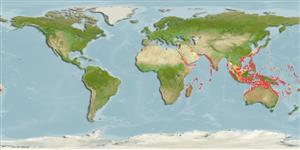Common names from other countries
Environment: milieu / climate zone / depth range / distribution range
Écologie
marin récifal; profondeur 10 - 70 m (Ref. 90102), usually 40 - ? m (Ref. 9710). Tropical
Indo-West Pacific: east coast of Africa east to New Caledonia; north to southern Japan.
Taille / Poids / Âge
Maturity: Lm ? range ? - ? cm
Max length : 20.0 cm SL mâle / non sexé; (Ref. 48635); common length : 31.0 cm TL mâle / non sexé; (Ref. 5450)
Épines dorsales (Total) : 13; Rayons mous dorsaux (Total) : 10; Épines anales: 3; Rayons mous anaux: 6 - 7. Reddish brown with alternating broad and thin dark bars separated by white; dark spot on cheek; small tentacle above eye which may be banded; upper half of pectorals with large dark spots on inner surface (Ref. 4313).
Found on the continental shelf (Ref. 75154). A rare inhabitant of rocky bottoms of deep offshore reefs. Normally found on soft-bottom or muddy substrates with rich rubble ridges amongst rich invertebrate growth, especially sponges (Ref. 48635). Sold fresh in small quantities in markets. Also found among soft corals, solitary or in small groups (Ref 90102).
Life cycle and mating behavior
Maturities | Reproduction | Spawnings | Egg(s) | Fecundities | Larves
Eschmeyer, W.N., 1986. Scorpaenidae. p. 463-478. In M.M. Smith and P.C. Heemstra (eds.) Smiths' sea fishes. Springer-Verlag, Berlin. (Ref. 4313)
Statut dans la liste rouge de l'IUCN (Ref. 130435)
CITES (Ref. 128078)
Not Evaluated
Menace pour l'homme
Harmless
Utilisations par l'homme
Pêcheries: intérêt commercial mineur
Outils
Articles particuliers
Télécharger en XML
Sources Internet
Estimates based on models
Preferred temperature (Ref.
115969): 24 - 28.6, mean 27.2 (based on 35 cells).
Phylogenetic diversity index (Ref.
82804): PD
50 = 0.5005 [Uniqueness, from 0.5 = low to 2.0 = high].
Bayesian length-weight: a=0.01047 (0.00539 - 0.02033), b=3.01 (2.84 - 3.18), in cm Total Length, based on LWR estimates for this species & (Sub)family-body (Ref.
93245).
Niveau trophique (Ref.
69278): 3.9 ±0.6 se; based on size and trophs of closest relatives
Résilience (Ref.
120179): Milieu, temps minimum de doublement de population : 1,4 à 4,4 années (Preliminary K or Fecundity.).
Fishing Vulnerability (Ref.
59153): Low vulnerability (14 of 100).
